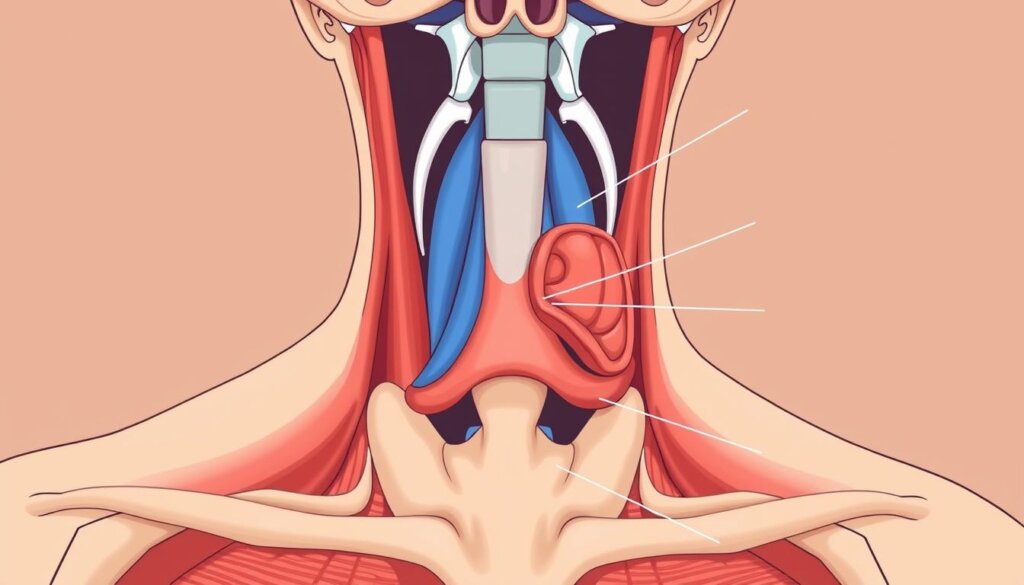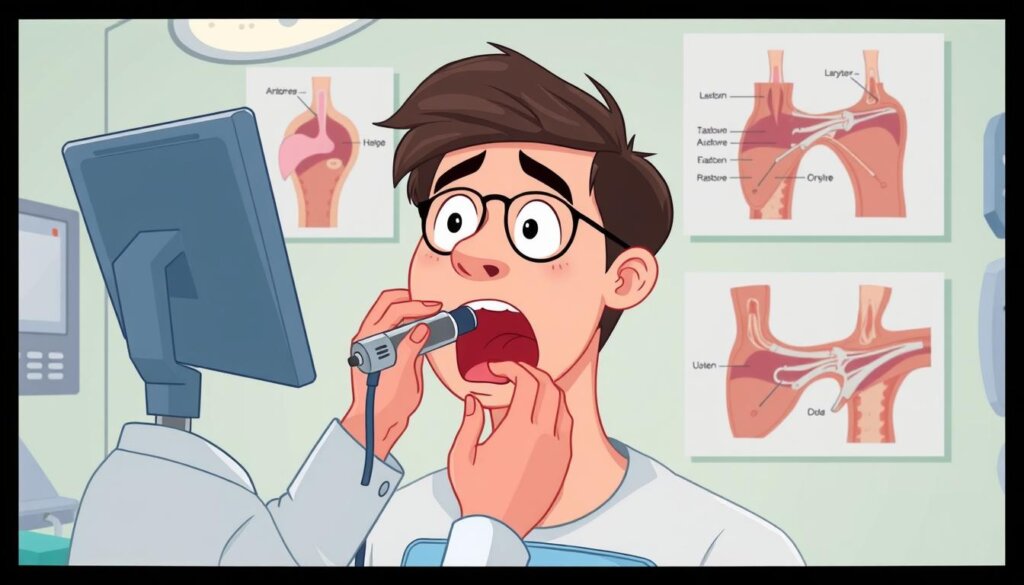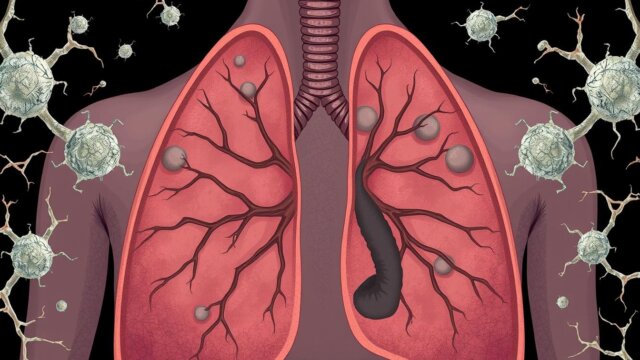FTC disclaimer: This post may contains affiliate links and we will be compensated if you click on a link and make a purchase.
About 55 out of 100 people with laryngeal cancer live for 10 years or more. This shows how serious laryngopharyngeal cancer is. It affects the larynx (voice box) and the pharynx (throat). Finding it early and treating it right is key to better outcomes.
This serious condition can cause breathing, swallowing, and speaking problems if not treated. This article will dive deep into laryngopharyngeal cancer. We’ll cover its symptoms, causes, diagnosis, staging, treatment options, and managing side effects. Knowing about this disease can help you get medical help early and recover better.
Key Takeaways
- Laryngopharyngeal cancer is a type of head and neck cancer that affects the larynx (voice box) and the pharynx (throat).
- Early detection and proper treatment are crucial for improving outcomes, as this serious condition can lead to difficulties with breathing, swallowing, and speaking if left untreated.
- Laryngeal cancer is more common in individuals over the age of 60 and is more prevalent in men compared to women.
- Laryngeal cancer is predominantly a squamous cell carcinoma, affecting the thin, flat cells lining the inside of the larynx.
- Known risk factors for laryngeal cancer include tobacco use and excessive alcohol consumption.
What is Laryngopharyngeal Cancer?
Laryngopharyngeal cancer starts in the larynx and pharynx. The larynx is where the vocal cords are. It’s also where we breathe, swallow, and talk. This makes the cancer very serious.
Anatomy of the Larynx and Pharynx
The larynx has three parts: the supraglottis, glottis, and subglottis. Cancer can happen in any of these areas or the pharynx. Knowing the anatomy helps us understand the cancer better.
Types of Laryngopharyngeal Cancer
The most common cancer is squamous cell carcinoma. It starts in the thin cells of the larynx and pharynx. Other types include adenocarcinoma, sarcomas, lymphoma, and plasmacytoma.
Smoking, acid reflux, and vocal strain can cause non-cancerous changes. These changes might turn into cancer. Knowing the types and causes helps doctors treat it better.

Symptoms of Laryngopharyngeal Cancer
Laryngopharyngeal cancer can show many symptoms, both early and late. Knowing these symptoms is key for early diagnosis and treatment.
Early Symptoms
In the early stages, symptoms may seem mild. They include a sore throat, hoarseness, trouble swallowing, and ear pain. If these symptoms last more than a few weeks, see a doctor.
Advanced Symptoms
As cancer grows, symptoms get worse. You might have trouble breathing, a neck lump, coughing up blood, and losing weight without trying. These symptoms can really hurt your life, and you need quick doctor help.
Not everyone with laryngopharyngeal cancer shows the same symptoms. Regular doctor visits and talking with your doctor are vital for catching it early.
“Early detection is key to successful treatment of laryngopharyngeal cancer. If you experience any persistent or unexplained throat or voice-related symptoms, don’t hesitate to consult a healthcare professional.”
Causes and Risk Factors
It’s important to know what causes and increases the risk of laryngopharyngeal cancer. The main risks are using tobacco products and drinking a lot of alcohol.
Other big risks include having a family history of head and neck cancer. Also, being exposed to harmful chemicals and eating too few fruits and veggies. Jobs that expose you to lung dangers can also raise your risk.
Tobacco and Alcohol Use
Using tobacco, like smoking or chewing, is a big risk for laryngopharyngeal cancer. The longer and harder you use tobacco, the higher your risk. Drinking a lot of alcohol, especially with tobacco, makes the risk even higher.
Other Risk Factors
There are other things that can increase your risk of laryngopharyngeal cancer:
- Having a family history of head and neck cancer
- Being exposed to harmful chemicals like asbestos and coal dust
- Eating too few fruits and veggies
- Having a weak immune system, like with HIV/AIDS or after an organ transplant
- Having certain health problems, like laryngeal dysplasia or systemic lupus erythematosus
- Having infections like Helicobacter pylori or human papillomavirus (HPV)
- Having gastro-oesophageal reflux disease (GORD)
Knowing and dealing with these risks can help prevent laryngopharyngeal cancer. 
“Reducing tobacco and alcohol use, eating well, and managing health issues can lower your risk of laryngopharyngeal cancer.”
Diagnosis of Laryngopharyngeal Cancer
Diagnosing laryngopharyngeal cancer needs a detailed approach. This includes a physical check, imaging tests, and a biopsy. First, a healthcare expert, like an otolaryngologist, will examine the throat and neck. They look for any signs of trouble.
If they find something odd, more tests might be needed. A laryngoscopy lets the doctor see the larynx and pharynx with a camera. This can be done directly or indirectly, with numbing meds for comfort.
At times, a panendoscopy is done. It’s a mix of laryngoscopy, esophagoscopy, and bronchoscopy. This thorough check is done under general anesthesia.
To be sure, a biopsy is often needed. A small tissue sample is taken for a microscope check. Endoscopic and fine-needle aspiration biopsies are common methods.
Imaging tests also play a big role. CT scans, MRI scans, chest x-rays, and PET scans help see the tumor’s size and location. These tests also check if treatment is working and if the cancer comes back.
Other tests like bone scans, barium swallows, and blood tests are used too. They help understand the patient’s health and the cancer’s details.
Quitting smoking is very important before and during treatment. Smoking can make treatment less effective and lead to worse results.

Diagnosing laryngopharyngeal cancer is complex. It involves physical checks, imaging, and biopsies. A team of healthcare experts works together to give patients a detailed and personal diagnosis and treatment plan.
Laryngopharyngeal Cancer: Symptoms and Treatment
Laryngopharyngeal cancer can make life hard. It can make it tough to speak, swallow, and breathe. Treatment often includes surgery, radiation, and chemotherapy. The goal is to get rid of the cancer and keep the patient’s quality of life.
In the early stages, symptoms may include hoarseness, coughing, or feeling a lump in the throat. As it gets worse, symptoms like hard or painful swallowing, breathing issues, and noisy breathing can happen.
Doctors use a laryngeal mirror or a video camera to check the throat. A biopsy might be needed to confirm the cancer.
Treatment depends on the cancer’s type, stage, and location. Early-stage cancers might just need surgery or radiation. But for more serious cases, chemotherapy might be needed too. Surgery, like robotic or laser surgery, might be an option for some early-stage cancers.
Early diagnosis and treatment can lead to good outcomes. About 65 out of 100 people live for 5 years or more after being diagnosed. And around 55 out of 100 people live for 10 years or more.
“Laryngeal cancer is more common in men than women, and it is more prevalent in individuals over the age of 60. Smoking and heavy alcohol consumption are significant risk factors for this type of cancer.”
Knowing about laryngopharyngeal cancer can help. It can lead to seeking medical help and working with doctors to manage the condition.
Staging of Laryngopharyngeal Cancer
The stage of laryngopharyngeal cancer is very important. It helps decide the best treatment and what the future might hold. The American Joint Committee on Cancer (AJCC) TNM system is used to classify the cancer. It looks at the tumor size, lymph node involvement, and if the cancer has spread to other parts of the body.
Staging Systems
Laryngopharyngeal cancer stages range from 0 to IV. Stage 0 is the least severe, and stages IVB and IVC are the most severe. The TNM system gives a detailed look at the tumor, lymph nodes, and if the cancer has spread.
Both supraglottic and glottic laryngeal cancers have similar staging. Lower stages mean the cancer is more localized. Higher stages mean it has spread more.
Importance of Staging
Getting the cancer stage right is key to treatment and knowing what to expect. Different stages need different treatments, like surgery or radiation. Early-stage cancers have better chances, but advanced cancers are harder to treat and have worse survival rates.
Knowing the stage of laryngopharyngeal cancer helps doctors plan the best treatment. It also helps patients understand their future. For the latest on cancer staging and treatment, check out the Healthy IOS website.
“Accurate staging is crucial in guiding treatment decisions and providing valuable information about a patient’s prognosis.”
Treatment Options
The main ways to treat laryngopharyngeal cancer are surgery, radiation therapy, and chemotherapy. The treatment plan varies based on several factors. These include the cancer’s stage, where it is, the type of cells, and the patient’s health.
Surgery
Surgery for laryngopharyngeal cancer might remove part or all of the larynx and/or pharynx. For cancers in the early stages (Stages 0-2), doctors might remove the bad area with a biopsy or laser. They might also do partial laryngectomy or radiotherapy and sometimes add radiotherapy after surgery.
In more serious cases (Stages 3 and 4), doctors might do laryngectomy with radiotherapy after. They might also use transoral robotic surgery (TORS) or supracricoid partial laryngectomy to keep the larynx working.
Radiation Therapy
Radiation therapy kills cancer cells with high-energy rays. It can be used alone or with surgery or chemotherapy. For early-stage laryngeal cancer, radiotherapy is often the main treatment. For more advanced stages, it’s used with chemotherapy or targeted drugs.
Chemotherapy
Chemotherapy uses medicines to kill cancer cells. It’s used with other treatments like radiation or targeted drugs for advanced cancer.
The 2016 UK National Multidisciplinary guidelines help understand treatment for laryngeal cancer. Studies and reviews, like comparing transoral laser surgery and radiotherapy for early glottic cancer, give detailed looks at how well treatments work.
“The type of treatment recommended depends on the stage of the cancer, the location within the larynx, the grade of abnormal cells, and the patient’s overall health and fitness level.”
Managing Side Effects
Treatments for laryngopharyngeal cancer can cause tough side effects. At NYU Langone’s Perlmutter Cancer Center, a team helps patients manage these effects. They aim to improve life quality during and after treatment.
Difficulty swallowing is a common side effect. It can be helped with speech and swallowing therapy. Patients might also face dry mouth, hoarseness, or fatigue. These can be eased with medicines, diet changes, and therapy.
- Speech therapy to improve swallowing and communication
- Treatments for dry mouth, such as saliva substitutes or medication
- Rehabilitation exercises to address muscle stiffness and lymphedema
- Nutritional support to maintain a healthy diet during and after treatment
- Therapies to manage neuropathy, fatigue, and other side effects
The Perlmutter Cancer Center also offers integrative therapies. These include acupuncture, yoga, and massage. They help reduce discomfort and improve well-being.
“The key to managing side effects is to have a comprehensive, multidisciplinary team that can address the physical, emotional, and practical needs of each patient,” explains a healthcare provider from the Perlmutter Cancer Center.
Patients can work with their team to create a plan. This plan helps manage side effects and keeps quality of life high.
Prognosis and Survival Rates
The outlook for laryngopharyngeal cancer varies based on several factors. These include the cancer’s stage, the patient’s age and health, and the treatment’s success. According to data from the American Cancer, early-stage cancer has a better chance of survival. It has a 5-year survival rate of about 65%. But, advanced-stage cancer is harder to treat, with a 5-year survival rate of about 55%.
The cancer’s location also affects survival rates. For example, cancer below the vocal cords has a survival rate of 38% for regional cancer to 59% for localized cancer. Cancer above the vocal cords has a survival rate of 30% for metastatic cancer to 61% for localized cancer.
It’s key to remember that survival rates give a general idea. They don’t account for individual differences or other factors like age and health. New treatments may also improve survival chances for those diagnosed today.
Cancer Stage | 5-Year Relative Survival Rate |
|---|---|
Early-Stage Laryngopharyngeal Cancer | Around 65% |
Advanced-Stage Laryngopharyngeal Cancer | Around 55% |
Localized Laryngeal Cancer in the Subglottis | 59% |
Regional Laryngeal Cancer in the Subglottis | 38% |
Localized Laryngeal Cancer in the Supraglottis | 61% |
Metastatic Laryngeal Cancer in the Supraglottis | 30% |
Regular check-ups are crucial for catching any cancer that comes back or new cancer. While survival rates give a general idea, each person’s outcome can differ.
Conclusion
Laryngopharyngeal cancer is a serious condition that needs quick diagnosis and full treatment. Spotting symptoms early and knowing risk factors can help a lot. Thanks to new treatments and team care, many people beat this cancer and live well.
Laryngeal cancer makes up 26-30% of head and neck cancers, most common in people 50-60 years old. Smoking makes it 20 times more likely, and LPR might also play a part. We need more research and learning to better fight this disease.
Laryngeal squamous cell carcinoma (LSCC) is rare, making up only 1% to 2% of all cancers worldwide. But we must watch for its signs and risk factors. Working with doctors and following guidelines can help prevent and treat it well, boosting your chances of a good outcome.
FAQ
What is laryngopharyngeal cancer?
Laryngopharyngeal cancer is a serious disease. It affects the larynx (voice box) and the pharynx (throat). If not treated, it can make breathing, swallowing, and speaking hard.
What are the symptoms of laryngopharyngeal cancer?
Early signs include a sore throat and hoarseness. You might also have trouble swallowing or feel ear pain. As it gets worse, you might notice a neck lump, coughing, breathing issues, and weight loss.
What are the risk factors for laryngopharyngeal cancer?
Smoking and drinking a lot of alcohol are big risks. A family history of head and neck cancer also matters. So does being around harmful chemicals and eating few fruits and veggies.
How is laryngopharyngeal cancer diagnosed?
Doctors use a physical check, imaging tests, and a biopsy to diagnose. They look for abnormalities and might use CT scans or MRIs. A biopsy is needed to confirm the cancer.
What are the treatment options for laryngopharyngeal cancer?
Treatments include surgery, radiation, and chemotherapy. The best plan depends on the cancer’s stage, your health, and what you want to achieve.
How are the side effects of laryngopharyngeal cancer treatment managed?
Side effects like swallowing trouble and dry mouth are common. Doctors use speech therapy and diet changes to help. They also suggest medicines to ease symptoms and improve life quality.
What is the prognosis and survival rate for laryngopharyngeal cancer?
Survival rates vary based on the cancer’s stage, age, and health. Early-stage cancer has a 65% 5-year survival rate. However, the advanced cancer rate drops to about 55%.








